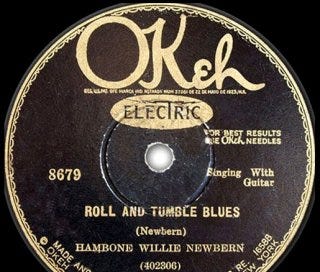A century after its creation, “Rollin’ and Tumblin’” still fills dance floors and provides musicians an unsurpassed avenue for self-expression. No one knows for sure when or how the song started, but it likely taps into one of the earliest blues strains. Following an AAB lyric pattern, the song typically has verses but no chorus. It does not follow the traditional 12-bar structure, but begins with two measures on the IV chord before resolving to the I chord. In some versions, the IV chord moves to IVb7 in the second measure. In its most cathartic version, by the Baby Face Leroy Trio, words give way to moans, whoops, and wails.
In January 1928, Cannon’s Jug Stompers recorded “Minglewood Blues” for Victor Records. This creaky-sounding jug band arrangement featured Gus Cannon on banjo and jug, Ashley Thompson on guitar and vocal, and harmonica ace Noah Lewis, who was credited with writing the song. Recorded in the Memphis Auditorium, this is the first known recording set to the “Rollin’ and Tumblin’” melody.
Hambone Willie Newbern's "Roll and Tumble Blues"
The next essential version, by Hambone Willie Newbern, gave the song its most familiar lyrics. Newbern made his recording in March 1929 for an OKeh Records field unit in Atlanta. Playing with fingers and slide on a guitar tuned to an open-G chord, Newbern framed his “Roll and Tumble Blues” as a dance tune. He began by singing:
“And I rolled and I tumbled and I cried the whole night long,
And I rolled and I tumbled and I cried the whole night long,
And I rose this morning, mama, and I didn’t know right from wrong
“Did you ever wake up and find your dough roller gone?
Did you ever wake up and find your dough roller gone?
And you wring your hand, you cry the whole day long”
Newbern hailed from Ripley, Tennessee. His nickname suggests that he wore a smoothed piece of hambone on one of his fretting fingers to gliss the strings, as others had done in the prewar South. Sleepy John Estes, who was born in Ripley and took guitar lessons from Newbern, recalled hearing Newbern play the song sometime between 1913 and 1917. It’s likely that when Newbern performed the song at gatherings, it extended beyond the three-minute limitation of a 78 rpm record.
In the song’s next notable appearance, Charley Patton used the melody for “Banty Rooster Blues,” recorded for Paramount Records at his debut session in June 1929. Three months later Sleepy John Estes, with Yank Rachel sitting in on mandolin, used Newbern’s melody and “dough roller” imagery for “The Girl I Love, She Got Long Curly Hair.” Estes began his Victor 78 with the lyric “Now I’m goin’ to Brownsville, take that right-hand road,” which showed up in later versions by Memphis blues great Furry Lewis. In November 1930, Noah Lewis recycled the melody from the Gus Cannon recording for “New Minglewood Blues,” cut for Victor with Estes on guitar, Rachel on mandolin, and Ham Lewis blowing jug.
Keep reading with a 7-day free trial
Subscribe to Talking Guitar ★ Jas Obrecht's Music Magazine to keep reading this post and get 7 days of free access to the full post archives.



